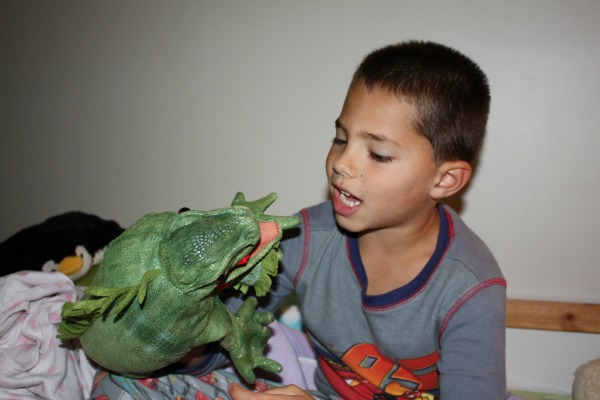Parents and bilingual teachers have a problem. At the beginning of a relationship, kids establish the language they want to use to communicate with an adult. Once established, it is not easy to convince the children to speak another language with them. Given this situation, what can parents and teachers who want to use two languages with the children do? One solution is to introduce the children to a puppet that only speaks the target language.
Many adults remember a puppet that they got to “know” in elementary school, and they remember the lessons that puppet taught them. In fact there are many academic studies that show the advantages of teaching with puppets. According to Allison Lepley of Fairfax County Public Schools (2001), children who learn through puppets have better oral comprehension, are able to more easily internalize language patterns and develop confidence and skills that help them work well in cooperative learning groups. All of these skills help to facilitate language learning.
The introduction of a “friend” creates a fun environment and helps to establish a new routine more easily. Children tend to be quite comfortable talk to puppets, and since the new puppet only speaks the target language, the adult doesn’t have to face the battle of convincing the kids to change the established relationship language. Simply put, everyone needs to speak the puppet’s native language so the new friend can understand everything.
Using a puppet is something that both teachers and parents can implement. At home a puppet can visit the children during playtime and play with the toys, games or puzzles. The children can also sing, dance or read with the puppet that can even teach them new vocabulary! As we always stress, developing literacy skills in the second language is important and the puppet can always “ask” the parents to read books in the puppet’s native language. A fun idea is to make or buy a puppet that is a character from one of the children’s favorite books. At school, the puppet can co-teach, directing lessons and activities in the native language.
Since playing with puppets and speaking with different voices in order to develop the puppet’s personality isn’t something natural for many adults, the blog Fun for Spanish Teachers has some great tips to facilitate the process:
- The puppet should look at the children even when it is talking to the adult.
- When two puppets are conversing, they should look at the children, not each other.
- When the puppet is talking, the adult should look at it.
- Don’t forget to move the mouth according to the syllables of the words, and don’t open its mouth too far.
With a little practice in front of a mirror and by implementing music, poems, games and reading, everyone can be successful teaching language with puppets. And don’t forget that adults aren’t the only ones who should use the puppets. One never knows how much a child with talk given the chance to converse with a puppet or make two puppets talk to each other!
Have fun!
*Lepley, A. (2001). How Puppetry Helps the Oral Language Development of Language Minority Kindergartners. Fairfax County Public Schools.





Puppets are a great idea for teaching another language!!! My son loves them!